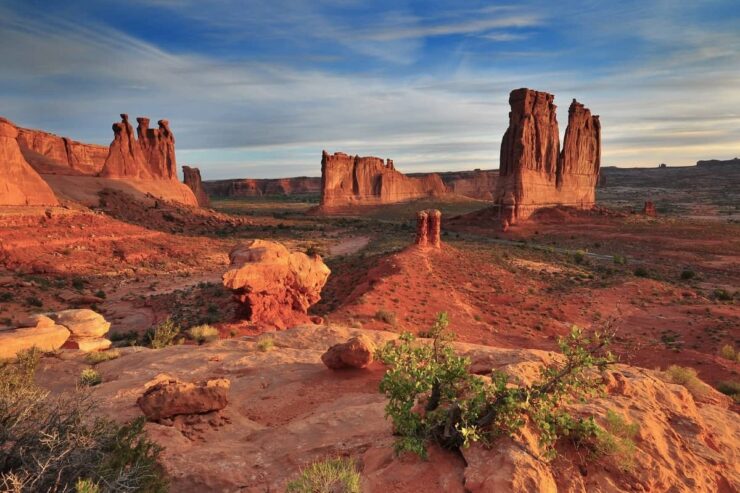Utah is home to a remarkable collection of National Parks, each offering its own unique natural beauty and adventures.
- Arches
- Bryce Canyon
- Canyonlands
- Capitol Reef
- Zion
These destinations invite exploration and provide unforgettable experiences in the great outdoors.
So, let’s find out what makes these national parks so popular.
1. Arches National Park
Arches National Park, situated in eastern Utah, showcases the remarkable power of nature. Imagine a place where you’ll find over 2,000 natural stone arches. Each one unique and awe-inspiring.
As you explore, you’ll encounter massive sandstone fins, gigantic balanced rocks, and towering pinnacles.
Photographers, hikers, and anyone who loves the outdoors will be captivated by this stunning landscape.
Unique Geological Features
Arches National Park is renowned for its natural stone arches, the highest density in the world.
The Delicate Arch, standing alone against the backdrop of La Sal Mountains, is perhaps the most iconic. Yet, every arch tells a story of millions of years of erosion and geological activity.
Hiking Trails and Outdoor Activities
For those eager to explore, the park offers a variety of trails. From the easy Landscape Arch trail to the challenging Devil’s Garden Primitive Loop, there’s something for every level of adventurer. Each path leads to breathtaking views and up-close encounters with the park’s unique geological formations.
Visitor Experience
Visitors to Arches can enjoy a range of activities beyond hiking. Scenic drives offer access to many of the park’s major attractions, while ranger-led programs provide insights into the park’s natural history, wildlife, and preservation efforts.
Conservation Efforts
The delicate ecosystem of Arches faces challenges from climate change and increased visitor traffic. Efforts to preserve the park’s natural beauty include habitat restoration projects and initiatives to reduce human impact, ensuring that this natural wonder remains for future generations.
Fun Facts
- Arches National Park has the densest concentration of natural stone arches in the world.
- The Landscape Arch, one of the park’s most famous features, spans longer than a football field.
- Nighttime offers a spectacular view of the stars, with the park being a designated Dark Sky Park.
2. Bryce Canyon National Park
Bryce Canyon National Park, located in southern Utah, is famous for its colorful and whimsical rock formations known as hoodoos.
These spire-shaped rock formations are the result of erosion and provide a stunning, otherworldly landscape that draws visitors from around the globe.
The Magic of Hoodoos
The park’s main attraction, the hoodoos, create a natural amphitheater that changes colors with the rising and setting sun.
Bryce Canyon is not a single canyon but a series of natural amphitheaters or bowls, carved into the edge of a high plateau.
The most famous of these is the Bryce Amphitheater, which is filled with irregularly eroded spires of rocks.
Hiking and Exploration
Bryce Canyon offers trails that range from easy strolls to strenuous hikes.
The Rim Trail offers panoramic views of the amphitheater, while the Navajo Loop and Queen’s Garden Trail allow visitors to hike among the hoodoos.
For those seeking a more challenging adventure, the Fairyland Loop and Peek-A-Boo Loop Trails provide longer distances and more elevation gain.
Night Sky Viewing
Bryce Canyon is also renowned for its dark skies, making it an ideal spot for stargazing.
The park is designated as a Dark Sky Park, and rangers offer night sky programs that allow visitors to gaze at the stars, planets, and the Milky Way with minimal light pollution.
Environmental Preservation
The unique geology and delicate ecosystems of Bryce Canyon are subject to erosion and human impact.
Park management employs strategies to minimize visitor impact on the fragile environment, including trail maintenance, limiting areas for exploration, and educating visitors on the importance of conservation.
Fun Facts
- Bryce Canyon is not actually a canyon but a collection of giant natural amphitheaters.
- The park’s highest elevation is over 9,000 feet (2,743 meters), offering breathtaking views and a cool climate even in summer.
- Bryce Canyon National Park is home to over 200 species of birds, making it a popular destination for birdwatching.
3. Canyonlands National Park
Canyonlands National Park, located in southeastern Utah, offers visitors a vast landscape of deep canyons, towering mesas, and remarkable rock formations carved by the Colorado River and its tributaries.
The park is divided into four districts: Island in the Sky, The Needles, The Maze, and the rivers themselves, each offering unique experiences and adventures.
The Four Districts
- Island in the Sky is the most accessible district, providing panoramic views from high above the surrounding terrain.
- The Needles offers more challenging hikes through its colorful spires of Cedar Mesa Sandstone.
- The Maze is a remote area known for its solitude and complex canyon systems.
- The Rivers district, encompassing the Green and Colorado rivers, offers opportunities for rafting and kayaking.
Adventures in the Wilderness
Canyonlands invites outdoor enthusiasts to explore its diverse landscapes through hiking, mountain biking, backpacking, and four-wheel driving.
The White Rim Road in Island in the Sky and the Elephant Hill in The Needles are popular among mountain bikers and four-wheel drivers for their challenging terrain and stunning vistas.
Cultural History
The park is not only a natural wonder but also a cultural treasure, with a history that includes petroglyphs and ruins left by the Ancestral Puebloans, as well as cowboy camps and uranium mining camps from more recent times.
Fun Facts
- Canyonlands is one of the least developed National Parks in the United States, offering a true sense of wilderness and adventure.
- The confluence of the Colorado and Green Rivers is a highlight of the park, visible from various overlooks.
- The park’s diverse ecosystems range from high desert to riparian areas, supporting a wide variety of plant and animal life.
4. Capitol Reef National Park
Capitol Reef National Park, nestled in south-central Utah, is a hidden treasure characterized by the Waterpocket Fold, a striking 100-mile long warp in the Earth’s crust.
This park is less crowded than its Utah counterparts, offering serene landscapes, rich history, and extensive hiking trails through canyons, arches, and red rock formations.
The Waterpocket Fold
The centerpiece of Capitol Reef, the Waterpocket Fold, is a geological monocline that has created a diverse topography of cliffs, canyons, domes, and bridges. This feature is a testament to the power of the Earth’s movements over millions of years.
Hiking and Exploration
Capitol Reef’s trails cater to all levels of hikers. The Capitol Gorge Trail and the Hickman Bridge Trail are popular among those seeking shorter hikes, while the more strenuous Rim Overlook and Navajo Knobs trails reward hikers with breathtaking panoramic views.
Rich Cultural Tapestry
The park’s history is as layered as its geology, with petroglyphs from the Fremont Culture, pioneer inscriptions, and the historic Fruita orchards, where visitors can pick fruit in season.
The Fruita area, once a Mormon settlement, now serves as the park’s main developed area, offering a glimpse into the past.
Fun Facts
- Capitol Reef was named for the white domes of Navajo Sandstone that resemble the U.S. Capitol building, and the “reef” refers to the impassable ridges that reminded early settlers of ocean reefs.
- The park is home to over 900 species of plants, making it a vibrant display of biodiversity.
- The historic Fruita Schoolhouse and the Gifford Homestead offer visitors a peek into the life of early settlers in the area.
5. Zion National Park
Zion National Park, located in southwestern Utah, is renowned for its steep red cliffs, narrow canyons, and beautiful vistas.
As Utah’s first national park, it offers visitors a blend of rich history, diverse ecosystems, and ample opportunities for adventure and contemplation.
Scenic Beauty and Geological Wonders
Zion is characterized by its high plateaus, rock towers, and mesas, cut through by the Virgin River’s deep canyons.
The park’s most famous feature, the Zion Canyon, is a striking gorge that offers stunning views and serves as the starting point for many of the park’s trails.
Trails and Outdoor Activities
The park provides a range of hiking opportunities, from the easy Riverside Walk to the strenuous Angel’s Landing and The Narrows.
Each trail offers unique perspectives of the park’s natural beauty, from serene river walks to breathtaking overlooks.
Diverse Habitats and Wildlife
Zion’s varied topography supports diverse habitats, from desert to riparian and woodland, home to a wide array of wildlife.
Visitors might spot mule deer, bighorn sheep, and numerous bird species, contributing to the park’s biological richness.
Historical and Cultural Significance
Human history in Zion spans thousands of years, from ancient Native American tribes to Mormon pioneers in the 19th century.
The park’s Human History Museum showcases the area’s cultural heritage, offering insights into its past inhabitants and their relationship with the land.
Fun Facts
- Zion National Park was originally named Mukuntuweap National Monument before being redesignated as a national park in 1919.
- The Narrows, one of the park’s most famous hikes, takes visitors through one of the narrowest sections of Zion Canyon, with walls towering thousands of feet above and sometimes only 20 to 30 feet apart.
- Zion is a haven for rock climbers, offering challenging routes like those on the park’s iconic monolith, the Great White Throne.
FAQs
What is the largest Utah National Park?
Canyonlands National Park is the largest in Utah, covering over 337,598 acres.
How many days do you need in Utah?
To visit Utah’s National Parks, a minimum of 7 to 10 days allows for a thorough exploration, including travel time between parks.
Why is it called Zion Park?
Zion National Park was named by early Mormon settlers, who referred to it as Zion, meaning a place of peace and refuge.
How far apart are Zion and Bryce?
Zion and Bryce Canyon National Parks are 72 miles apart, about a 1.5-hour drive.
Conclusion
Utah’s National Parks offer a unique blend of natural beauty and adventure. From the arches that frame the sky to the canyons carved by rivers, each park presents its own set of marvels.
Whether you seek the solitude of the desert or the thrill of a challenging hike, these parks provide an escape into nature where the grandeur of the landscapes speaks for itself.
Utah’s Mighty Five stand as a testament to the natural world’s beauty, inviting explorers from around the globe to discover their secrets.

